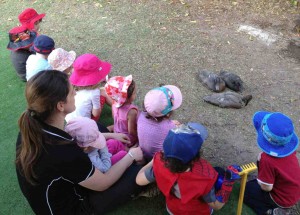The pic, left, is from Sorenne’s pre-school yesterday.
The teachers-that-be decided at some point it was a good idea to get a chicken coup for the pre-school; I said it may be a bad idea, sent them a bunch of info about outbreaks, and left it at, you have to be a lot more careful than you thought.
There were some chickens in there for two weeks during spring break, and they came
 from the grade 3 class across the road.
from the grade 3 class across the road.
These are ducks; they came from one of the teachers, who fancies herself a bit of a foodie, but at least isn’t snobbish about it.
I asked if the ducks had pooped, because kids can’t be watched all the time in a 6-kid-1-teacher ratio.
Sorenne has taken to putting all sorts of things in her mouth and on the table when eating. I try to explain the be-the-bug concept; like today, Sorenne and I had lunch with a friend and his two pre-school daughters. They were putting flip-flops on the table; Sorenne was eating the menu. These are things kids do. The microbiological explanation didn’t go very far. The communal fries came with aioli dipping sauce, so I had to ask the café staff, how was the aioli made?
Raw eggs, but whole eggs.
Pasteurized or cooked?
I didn’t have any. Neither did Sorenne.
Kids will do all sorts of things, so platitudes about handwashing stations at petting zoos and washing hands when dealing with potentially risky things is nice but never enough.
The U.S. Centers for Disease Control reports a total of 195 persons infected with the outbreak strains of Salmonella Infantis, Salmonella Newport, and Salmonella Lille were reported from 27 states.
• 34% of ill persons were hospitalized;
• two deaths were reported; and,
• 33% of ill persons were children 10 years of age or younger.
Epidemiologic, laboratory, and traceback findings linked this outbreak of human Salmonella infections to contact with live poultry from Mt. Healthy Hatchery in Ohio.
Mail-order hatcheries, agricultural feed stores, and others that sell or display chicks, ducklings, and other live poultry should provide health-related information to owners and potential purchasers of these birds prior to the point of purchase. This should include information about the risk of acquiring a Salmonella infection from contact with live poultry.

